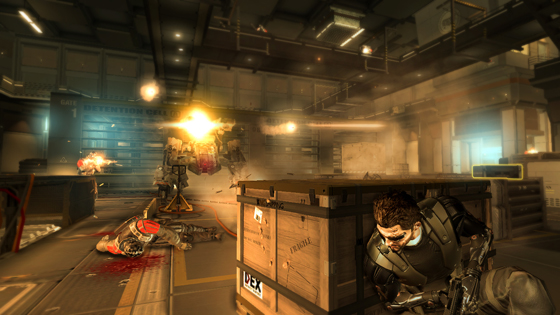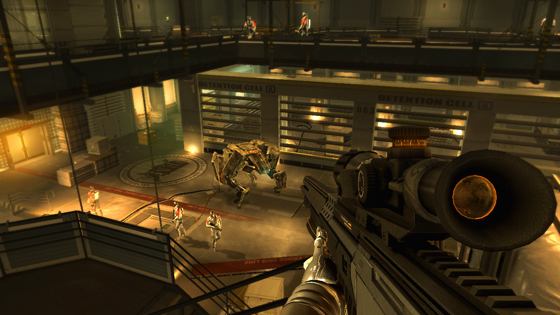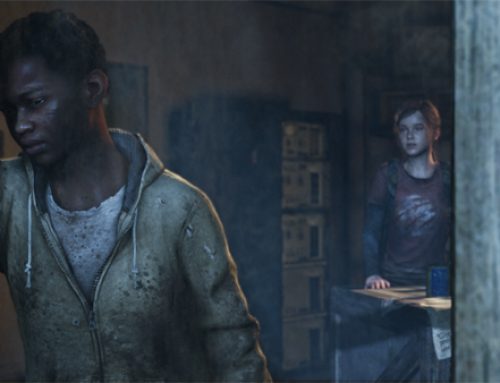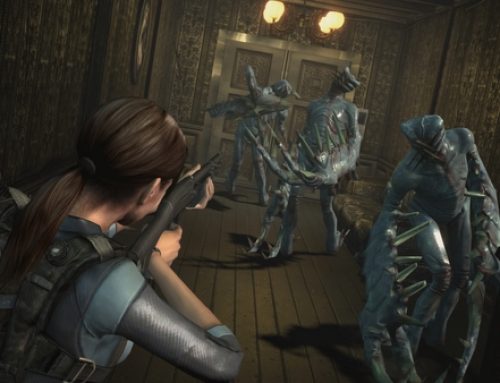Ever since November, it seems we’ve been inundated with first-person shooters, many of which have required us to progress through fairly linear levels, killing stuff. And while some of these, such as the irreverent, giddy “Bulletstorm,” were incredibly stylish and fun, jaded older gamers could be forgiven for wondering how long we’d have to wait before we got to play a more open-ended adventure.
I recently got to take a look at “Deus Ex: Human Revolution,” Eidos Montreal’s upcoming hybrid of role-playing game, first-person shooter and cyberpunk stealth game. While I came away intrigued by the way the game lets players tackle its problems in multiple ways, I was equally tantalized by a conversation I had with one of the game’s developers as my guided tour was winding down.
But I’m getting ahead of myself.
“Human Revolution,” a prequel to the previous two “Deus Ex” games helmed by critical darling Warren Spector, takes place in the year 2027, which game designer Antoine Thisdale described as a “turning point for humanity.”
The main character is Adam Jensen, an ex-cop who, thanks to an ex-girlfriend’s connections, got a job working as head of security for Sarif Industries, a biotechnology company that’s pioneering the use of a new technology called cybernetic enhancements.
Sarif is run by David Sarif, an apparent altruist who’s based his company in Detroit with the aim of revitalizing the city. But, as Thisdale explained, Detroit hasn’t quite gotten there yet. Parts of the city are still run-down and crime ridden, while others sparkle and bear the fruits of Sarif’s largess.
“The city is still a bit crummy when you walk downtown,” Thisdale said. “But it’s got a new life … because of the augmentation business.”
Because the Eidos studio making “Human Revolution” is based in Montreal, I was curious as to what sort of legwork went into trying to capture the feel of what a biotech-infused Detroit might look like in the year 2027. Thisdale said that while the team studied government photos of Detroit and acquainted itself with the city’s history, they created their future Motor City based more on feel, as opposed to striving for historical accuracy, then futurizing everything.
“We sort of made it into what we think is cool,” he said.
This new Detroit, in which urban decay and renewal exist side-by-side, serves as the core locale for “Human Revolution’s” story as well as, I’m guessing, an extended metaphor for the way the game’s cybernetic enhancements are grafted to imperfect human tissue.
Near the beginning of the game, a team Adam is part of gets ambushed by mercenaries, and the damaged ex-cop is then modified with cybernetic enhancements. The mission I saw, which takes place five or six hours into the game, begins with Adam following a lead to a training camp used by the mercs.
As he played the demo, Thisdale explained how Eidos Montreal has designed “Deus Ex” to be much more than your typical, “Go there, shoot stuff until everyone’s dead” shooter. The team sees the game revolving around the four concepts of combat, stealth, hacking and social interactions. I got to see each of these in action.
I got a taste for the social interaction right away, as Thisdale guided Adam over to an arms dealer to buy supplies and gather a little intelligence about what had been doing down in the area. You’ll be able to talk to each character you meet in “Human Revolution,” Thisdale explained. Some characters, such as this arms dealer, offered only a bit of info. You just select “info” when you talk to the guy and he tells you what he knows.
In other encounters, though (and here’s where I get excited), you’ll have dynamic conversations with nonplayer characters. It’s clear that the team at Eidos Montreal isn’t just ripping off BioWare’s tried-and-true dialogue trees, however. In interacting with characters, you’ll have to tailor your approach to their moods or, in Thisdale’s words, “listen and watch body language to figure out what they really want.”
“If you piss people off, they may not want to talk to you at all,” he added. Also, if you’re a jerk to the wrong people, word can get around and other characters you meet elsewhere in the game may become less cooperative as a result.
Once Adam had cased the facility where the mercs were holed up, Thisdale showed me how “Deus Ex” will support multiple play styles and tactics, with large, nonlinear levels that can be tackled in multiple ways. You can go in guns blazing, or adopt a stealthy approach.
Combat is what you expect it to be: Walking around and shooting stuff. But, like “Crysis 2,” the game I’m playing at the moment, “Deus Ex” also supports gamers favoring a stealth approach. By choosing to upgrade different cybernetic enhancements via the game’s role-playing-gamelike customization, you can move through the large, nonlinear levels without drawing attention to yourself if you’re careful enough.
I watched Thisdale employ both approaches, with the stealth option seeming like the more intriguing of the two approaches. In one portion, Thisdale used the game’s cover system to move Adam stealthily through the levels so he could take down guards with stun and tranquilizer guns and disable cameras.
Players will need to manage their arsenal of weapons and gadgets carefully, though. The game features a “Resident Evil”-style inventory grid, with each piece of equipment taking up a certain portion of the overall rectangle. Though such a system doesn’t really reflect how the average Joe packs a bag, but the overall effect is the same. You won’t be able to tote around eight different weapons so you can pull out the perfect gun for each situation because they’re not going to all fit in your bag.
As Adam skulked around, Thisdale had the protagonist try to open a gate with his hacking skills. It’s kind of tough to describe here, but suffice it to say it’s more interesting than the pipe-based hacking minigame in the first “BioShock” and not as soul-sucking as what we encountered in “Dead Space: Ignition.” Hacking is stat based, which means each move you make in the hacking minigame risks detection slightly.
As you shoot, sneak and hack your way through levels, you’ll be able to take advantage of and upgrade Adam’s augmentations and equipment. One augmentation I saw in play made sneaking through the levels much easier, while a piece of equipment allowed Adam to mark multiple targets and then shoot several of them at once, like Sam Fisher in “Splinter Cell Conviction.”
Though “Human Revolution’s” levels can be tackled via multiple approaches, don’t expect an open-world game. Thisdale was quick to point out that “Human Revolution” is still a guided narrative with a set arc. Even though this caused my heart to sink a bit, my interest was piqued again when Thisdale started talking about all the extra stuff there was to uncover as you play through “Human Revolution.”
A full half the game, he said, “is not in the story’s critical path,” meaning players may have to give “Human Revolution” a few goes to experience all its nuances. What’s more, the social interactions are quite nuanced. Unlike BioWare’s games, you won’t be able to painstakingly exhaust every single option in a dialogue tree, getting each person you talk to to recite every possible detail that might be of use to you (and many that aren’t.) Chances are, as you treat people you meet differently or follow different lines of questioning, you’ll steer the narrative in different directions.
What’s more, “Human Revolution” has multiple endings. I couldn’t even get a ballpark figure out of Thisdale, and it’s clear the team has been ordered not to discuss this. But we know we’ll get at least two, and that’s not a bad starting point.
“Deus Ex: Human Revolution” is due out Aug. 23 for $60 on Xbox 360 and PlayStation 3, $50 on PC.





